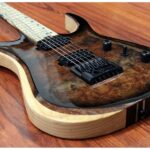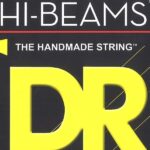The Fender Acoustasonic Telecaster is a one-of-a-kind hybrid guitar that combines the iconic Telecaster design with acoustic tones and capabilities.
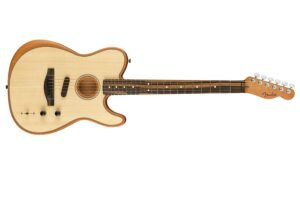
It has become popular among artists seeking a versatile instrument capable of producing electric and acoustic tones. However, the Acoustasonic Telecaster, like any other guitar, has drawbacks.
This blog post will look at some of the most typical issues users may find when using this new instrument.
Contents
Intonation Issues
Intonation refers to the accuracy of the guitar’s pitch across the entire fretboard.
Intonation issues occur when the guitar fails to produce notes in tune with each other, resulting in chords that sound sour or out of tune.
Intonation problems can be attributed to incorrect saddle placement, worn-out strings, or a warped neck. Adjusting the saddle positions can often help improve intonation.
However, if the issue persists, it may require professional attention to address more significant problems, such as a twisted neck.
Electronics and Pickup Malfunctions
As a hybrid guitar, the Fender Acoustasonic Telecaster’s advanced electronics and pickups contribute to its versatile tonal capabilities. However, these components can sometimes experience malfunctions.
Common electronic problems include crackling or popping sounds, intermittent signal loss, or complete failure. These issues may arise due to loose connections, faulty wiring, or worn-out components.
If you encounter such problems, having the guitar inspected by a qualified technician is advisable to diagnose and repair the specific issue.
Pickup malfunctions, such as weak or dead spots in the output, can also occur. This can affect the overall tonal balance and response of the instrument.
In some cases, adjusting the pickup height or replacing the pickup may be necessary to restore optimal performance.
Battery Drainage
The Fender Acoustasonic Telecaster uses battery power to operate its electronics, including the acoustic sound engine and onboard controls.
One common problem that users may face is battery drainage or power-related issues. This can manifest as a sudden loss of power or a shortened battery life.
A number of variables can contribute to battery drain. Even when the guitar is not in use, leaving it plugged in or forgetting to detach the cord after usage might deplete the battery.
Furthermore, if the battery compartment is not properly closed, it might result in a weak connection and eventually drain the battery.
Output Jack Connectivity Problems
The output jack is an essential component that allows the Fender Acoustasonic Telecaster to connect to an amplifier or audio interface.
However, users may encounter output jack connectivity problems, resulting in no sound or intermittent sound output.
These issues can be caused by loose connections between the output jack and the guitar’s wiring.
Over time, the constant plugging and unplugging of cables can lead to a weakened connection. Additionally, dust, debris, or oxidation can accumulate in the output jack, hindering proper electrical contact.
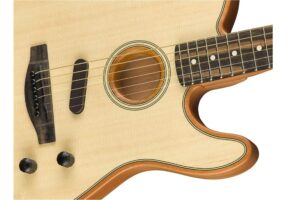
Action Adjustment Difficulties
A guitar’s action refers to the strings’ height above the fretboard. Some users may experience difficulties when attempting to adjust the action on their Fender Acoustasonic Telecaster.
Action adjustment difficulties can be attributed to several factors. The guitar’s truss rod, which provides neck relief, may require adjustment to achieve the desired action.
However, improper adjustments can lead to buzzes or affect playability.
Neck Stability and Warping
Neck stability is crucial for maintaining proper playability and intonation on any guitar, and the Fender Acoustasonic Telecaster is no exception.
Users may encounter issues with neck stability and even neck warping, which can affect the overall performance and playability of the instrument.
Neck stability problems can arise due to various factors, including changes in temperature and humidity, inadequate storage conditions, or poor-quality materials.
If the neck becomes warped, it can result in high action, string buzz, or even intonation issues.
Feedback and Acoustic Resonance Issues
The Fender Acoustasonic Telecaster’s design incorporates acoustic resonance chambers to enhance its acoustic sound.
However, users may encounter feedback issues when playing at higher volumes or dealing with unwanted resonances that affect the overall sound quality.
Feedback occurs when the sound from the amplifier is picked up by the guitar’s body and strings, causing a squealing or howling sound.
This can be particularly challenging when using high-gain settings or playing in loud environments. To mitigate feedback issues, using feedback suppressors or soundhole covers can be helpful.
Control Knob and Switch Malfunctions
Control knobs and switches are critical components of the Fender Acoustasonic Telecaster’s electronics, allowing players to adjust tone and switch between different pickup configurations.
However, users may experience issues with the control knob and switch malfunctions.
These problems can manifest as crackling or popping sounds, erratic behavior, or complete failure of the controls.
Loose connections, worn-out components, or dust and debris accumulation within the control cavity may cause malfunctions.
To address control knob and switch malfunctions, it is advisable to inspect the wiring and connections for any loose or damaged parts.
String Breakage
String breakages are an unfortunate but common issue that guitarists may encounter with their Fender Acoustasonic Telecaster.
When a string breaks, it can be frustrating and disruptive, especially during performances or recording sessions.
Several factors can contribute to string breakages, and understanding them can help guitarists take preventative measures.
One significant factor leading to string breakages is excessive tension. When a guitar is tuned to a higher pitch or using heavier gauge strings, the tension on the strings increases.
If the tension surpasses the strings’ breaking point or if there is a flaw or weak point in the string, it may snap during playing.
Playing style also plays a crucial role. Aggressive strumming or picking can stress the strings more, increasing the likelihood of breakages.
For guitarists who play with a heavy hand or frequently perform vigorous bends and vibrato, string breakages can become more frequent.
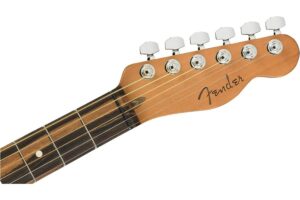
Moreover, the age and condition of the strings themselves are significant factors. Old, worn-out strings are more susceptible to breaking as they lose their elasticity and strength over time.
It is essential to regularly change strings, especially if they are showing signs of wear, to prevent unexpected breakages.
Environmental conditions can also impact string longevity. High humidity levels can cause strings to corrode faster, weakening their structural integrity and making them more prone to breaking.
Conversely, low humidity can lead to dryness and brittleness in the strings.
Additionally, sharp edges or burrs on the guitar’s bridge, saddle, or nut can damage the strings over time, eventually leading to breakages.
Regularly inspecting these contact points and smoothing out any rough edges can help prevent unnecessary stress on the strings.
Solder Joint Failures
Another issue that some Fender Acoustasonic Telecaster owners may encounter is solder joint failures. Solder joints are connections that hold the guitar’s electronic components together.
These connections are crucial for transmitting signals between different parts of the circuit, including pickups, controls, and output jack.
Solder joint failures can occur due to several reasons, such as poor soldering during the manufacturing process, frequent movement and vibrations of the guitar, or exposure to temperature and humidity fluctuations.
When a solder joint fails, it can lead to various problems, such as intermittent or complete loss of sound, scratchy or distorted signals, or malfunctioning controls.
Takeaway
While the Fender Acoustasonic Telecaster boasts innovative features that blend electric and acoustic tones, it is not without its problems.
Despite these drawbacks, Fender’s ongoing commitment to product improvement and customer satisfaction gives hope for resolving these issues.
If you’re considering an Acoustasonic Telecaster, be mindful of potential problems but also consider its unique capabilities.



